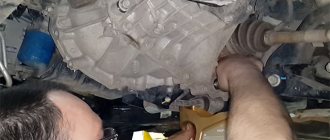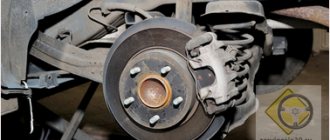- OilMarket
- Services and prices
- Changing the engine oil
- Changing oil in gearboxes
- Changing the automatic transmission oil
Changing the oil in an automatic transmission is the most important activity of our company. We carry out work in strict accordance with the recommendations of car manufacturers. Our car service has all the necessary equipment, which is staffed by experienced specialists.
| Service | Price | lead time | ||
| Automatic transmission fluid replacement (partial) | 800 rub. | 48 minutes | ||
| Automatic transmission fluid replacement hardware (100%) | 1200 rub. | 72 minutes | ||
Frequency of automatic transmission oil changes
For automatic transmissions, timely oil changes are very important; the quality of the box’s operation and how long it will last directly depend on it. This frequency is different for each box; it is written in the vehicle’s operating manual that comes with it. And, therefore, it is necessary to rely primarily on it, but if you use the car in extreme conditions, this period is halved. Extreme environments for automatic transmissions are:
• Constant overload of the car, increasing the load on the box. • Off-road. • Hot climate, which causes the machine to overheat. • Severe frosts contribute to thickening of the transmission fluid. • Constant traffic jams, due to which you have to stop and start again often. • A very harsh driving style, if this point applies to you, think about it, maybe you should change your driving style?
After all, sudden movements while driving have a detrimental effect on all components of the car. In general, if you take the average Russian car enthusiast, you can safely say that he uses the car in an extreme environment. So, feel free to divide the oil change period indicated in the operating manual into two. The frequency of replacing transmission fluid also varies depending on how to change the fluid, for example, by changing it yourself, whether it is a partial change or using a machine (this is described below).
Complete replacement
What is better - a full or partial automatic transmission oil change for a Camry? There is no clear answer to this question. But below we present a number of cases in which a complete replacement is simply necessary:
- If you plan to switch to another brand of oil.
- If you purchase a car on the secondary market.
- When performing automatic transmission repairs.
- When replacing an automatic transmission.
If there are any doubts as to what kind of oil change should be performed in the Toyota Camry 40 2.4 automatic transmission - full or partial, you need to pay attention to all of the above factors. If at least one is present, it is better to resort to the full method. The operation itself is performed in several stages:
- The entire transmission is washed using a special fluid.
- Old oil is replaced by pressing.
- The filter and pan gasket are replaced (since the latter always needs to be disassembled when changing the cleaning element).
What answer do experts give to the question of what is better – a complete or partial oil change in an automatic transmission? The craftsmen note that this method (complete replacement) will completely clean the insides of the box from existing dirt and deposits. This is a more correct replacement method from a technological point of view. But there are a few things to note:
- This operation is only possible with specialized equipment. Therefore, you cannot do without the help of specialists from the service station.
- A full replacement requires more fluid. For example, if the filling volume of an automatic transmission is ten liters, then the replacement will take about twelve.
What kind of oil change should be done in the Solaris automatic transmission - complete or partial? Experts say that if an unknown oil was poured into the box before the purchase, then you should only resort to a complete replacement. If it is partial, no one can guarantee that such a liquid will work normally. After all, each oil has its own tolerances.
Is it necessary to change the oil in maintenance-free automatic transmissions?
Increasingly, car manufacturers have begun to deprive us of the opportunity to change transmission fluid by eliminating the oil dipstick and drain hole from the unit. This is due to the fact that manufacturers have begun to fill automatic transmission fluid for the entire life of the vehicle, but the question is - what should we, Russians, whose vehicle operating conditions are close to extreme, or are so, do? Change cars twice as often? But, often, we do not have such budgets and it is, at least, not practical to change several cars in a short period of time. Naturally, transmission fluid poured into such boxes copes with loads much more efficiently and provides increased wear resistance of gearbox parts. But in our conditions this is still not enough, and many car owners have no idea what kind of terrible oil their expensive automatic transmissions operate on, without the technical ability to change the transmission. After all, all the wear products, all these chips and so on, all this accumulates in it, and the transmission becomes worse and worse and each time brings the failure of this unit closer. So when choosing a car, be sure to take this factor into account and be sure to check which gearbox is installed in the car you are interested in. Of course, even in the case of a maintenance-free automatic transmission, you can cheat a little and change the transmission fluid. This is done according to the scheme “refill as much as you drain.” But you need to treat this procedure with extreme caution, because you will not have the opportunity to find out how much transmission is in the box. Therefore, after draining the waste, you must first measure its volume, and only then pour the same amount of fresh liquid back in. It is also important to take into account that when heated, the transmission expands, which means that replacement must be made after first cooling the box.
Let's sum it up
The decision to save money and independently maintain an automatic transmission is an important point for every car owner. But if you have an extra couple of thousand rubles, it is better to entrust the service process to professionals. In this case, you will only have to observe the process, and not take on the responsibility of performing all tasks efficiently. That is why most motorists prefer only professional services from a good car service center.
However, with a little skill, it is quite possible to perform a high-quality automatic transmission oil change yourself. This procedure, if performed correctly, will not require repetition over the next 50,000 kilometers. Therefore, try to do everything efficiently and refuse to save on oil and consumables. If you have anything to add to our guide, be sure to share your experience in the comments.
Changing the oil in an automatic transmission
Changing the oil in an automatic transmission occurs using several methods; let’s look at them in more detail:
Method one
First of all, let's talk about what a partial oil change in an automatic transmission is. In this way, you can make a replacement either with your own hands or in a car service. 1. Unscrew the drain plug, and if it is missing, remove the entire crankcase and drain the waste. During the oil change process, we check it for chips and other wear elements, clean the magnets, or completely replace the filters. 2. We measure the volume of drained oil and, based on these indicators, fill in new oil. In order to fill it, we tighten the drain plug, if we removed the crankcase, put it in place, and after that, through the connector for the dipstick. This option is the most basic, but its disadvantage is that quite a lot of waste remains in the box and in order to completely get rid of it, this procedure must be carried out several times (about three to five). And in order to mix old oil and new, you need to lift (jack up) the front of the car and switch the gearbox lever to drive mode and while working, the box pumps fluid, mixing new oil and old. This type of oil change does not require any special skills, but it takes a lot of time, and in addition you need to have a suitable place.
Second method
The next method is carried out using a cyclic oil change device. There are two hoses in the gearbox; they usually lead either to the automatic transmission radiator or to the heat exchanger section of the box. These hoses are unscrewed, and this device, into which new oil has already been pre-filled, is attached to them. Next, start the engine and put the gear lever in the drive position, having previously hung the car on a lift. The process takes place within two hours, you can observe it using a special viewing window installed on this device, by looking into it you can see how the old oil is replaced by new oil. Using this method, you can also first dismantle the crankcase and drain the used oil, unscrew the filter and replace it, or clean the magnets, then install everything back and add fresh oil to the dipstick. Then, during the oil change itself, less new oil will be wasted. It is also worth considering that this method of changing oil uses about 12 liters of transmission fluid. This method is nothing more than a complete oil change in the automatic transmission.
Method three
Another way is a complete independent oil change in the automatic transmission. In essence, the cyclic replacement device is a capacity and a display meter. The automatic transmission itself can displace oil through heat exchange hoses. Here's how this process happens: 1. First, the oil is drained from the automatic transmission crankcase, the filter is checked and the magnets are cleaned 2. Next, new oil is poured through the hole for the dipstick, so that it is slightly above the maximum mark 3. Then the hose leading from boxes of liquid, and immerse it in a specially prepared plastic bottle (the container is needed for one and a half or two liters) 4. Start the engine and wait until the used oil fills the bottle, but not to the top, then turn off the engine and wait another couple of minutes until the bottle is filled to end. 5. Pour more new oil through the same hole and repeat the process again and again until clean oil flows into the bottle. It is worth warning that changing the oil in an automatic transmission with your own hands is highly undesirable due to the complexity of the design and the lack of proper skills on the part of a typical car enthusiast; this can result in extremely undesirable consequences for you. Therefore, we strongly recommend that you contact specialized service stations.
Why is there oil in the automatic transmission?
Everyone knows why oil is needed in car components - in order to reduce friction, ensure lubrication of parts, protect mechanisms from corrosion and rapid wear. The oil also allows you to slightly cool the parts - during operation, the temperature of many components can rise to 600-800 degrees Celsius. The gearbox oil is used in the same way. However, this is relevant, first of all, for manual transmissions. An automatic transmission, of course, uses oil for the same thing - but this is by no means its main function.
Oil condition inspection
The fact is that in automatic transmissions, oil (or rather, transmission fluid - ATF) is the so-called “working fluid”, which is involved in the transmission of torque. The exception is CVT boxes - they have a slightly different operating principle. It turns out that for an automatic transmission the oil requirements are much higher than for a manual transmission.
For example, if the oil in a manual transmission foams (this happens if there is too much oil in the box or when two different types of fluid are mixed), this will only lead to increased wear - since the foamed oil loses its lubricating properties. If this happens in an automatic transmission, it may stop working altogether). Therefore, the quality of its operation directly depends on the state of the ATF in the machine. But during operation, the properties of the oil change! There are some operating conditions that negatively affect the quality of the oil and its service life:
- excessively high loads on the automatic transmission (usually due to constant driving with a load - trailers, a large number of people in the car, driving with a low ATF level);
Why is there oil in the automatic transmission?
- poor road conditions (everyone knows that off-road driving is one of the most common causes of “early death” of automatic transmissions);
- low fuel quality (in this case, the required power develops at higher crankshaft speeds, and this implies a higher oil temperature in the box);
- “ragged” driving rhythm (frequent alternation of acceleration and deceleration, “start-stop” city traffic jams);
- Ambient temperatures are too low (ATF viscosity increases too much);
- ambient temperatures are too high (in addition to the fact that the box overheats faster, the ATF viscosity drops too much);
- quick start from a standstill (even boxes that have a warm-up mode are not recommended to be given a high load from a standstill, since the oil has not yet warmed up to operating temperature);
- slipping on ice, snow, sand and mud (in general, for such situations, the machine has a winter mode, in which the start is made from second gear, it is recommended to use it in the described conditions).










